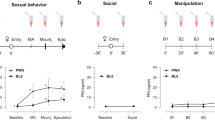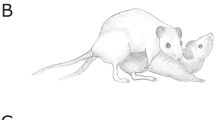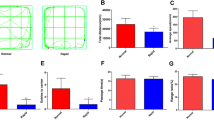Abstract
Most of our current understanding of the neurobiology, neuroanatomy and psychopharmacology of sexual behavior and ejaculatory function has been derived from preclinical studies in the rat. When a large population of male rats is tested on sexual activity during a number of successive tests, over time individual rats display a very stable sexual behavior that is either slow, normal or fast as characterized by the number of ejaculations performed. These sexual endophenotypes are postulated as rat counterparts of premature (fast rats) or retarded ejaculation (slow rats). Psychopharmacology in these endophenotypes helps to delineate the underlying mechanisms and pathology. This is illustrated by the effects of serotonergic antidepressants and serotonergic compounds on sexual and ejaculatory behavior of rats. These preclinical studies and models contribute to a better understanding of the neurobiology of ejaculation and boost the development of novel drug targets to treat ejaculatory disorders such as premature and retarded ejaculation.
This is a preview of subscription content, access via your institution
Access options
Subscribe to this journal
Receive 8 print issues and online access
$259.00 per year
only $32.38 per issue
Buy this article
- Purchase on Springer Link
- Instant access to full article PDF
Prices may be subject to local taxes which are calculated during checkout



Similar content being viewed by others
References
Lobo RA et al. Comparative effects of oral esterified estrogens with and without methyltestosterone on endocrine profiles and dimensions of sexual function in postmenopausal women with hypoactive sexual desire. Fertil Steril 2003; 79: 1341–1352.
Larsson K, Ahlenius S . Brain and sexual behavior. Ann NY Acad Sci 1999; 877: 292–308.
Pfaus JG . Neurobiology of sexual behavior. Curr Opin Neurobiol 1999; 9: 751–758.
Ågmo A . Sexual motivation—an inquiry into events determining the occurrence of sexual behavior. Behav Brain Res 1999; 105: 129–150.
Pfaus JG, Heeb MM . Implications of immediate-early gene induction in the brain following sexual stimulation of female and male rodents. Brain Res Bull 1997; 44: 397–407.
Veening JG, Coolen LM . Neural activation following sexual behavior in the male and female rat brain. Behav Brain Res 1998; 92: 181–193.
Truitt WA, Coolen LM . Identification of a potential ejaculation generator in the spinal cord. Science 2002; 297: 1566–1569.
Truitt WA, Shipley MT, Veening JG, Coolen LM . Activation of a subset of lumbar spinothalamic neurons after copulatory behavior in male but not female rats. J Neurosci 2003; 23: 325–331.
Waldinger MD, Olivier B . Selective serotonin reuptake inhibitor-induced sexual dysfunction: clinical and research considerations. Int Clin Psychopharmacol 1998; 13(suppl 6): S27–S33.
Olivier B, van Oorschot R, Waldinger MD . Serotonin, serotonergic receptors, selective serotonin reuptake inhibitors and sexual behaviour. Int Clin Psychopharmacol 1998; 13(suppl 6): S9–14.
Bitran D, Hull EM . Pharmacological analyis of male rat sexual behavior. Neurosci Biobehav Rev 1987; 11: 365–389.
Melis MR, Argiolas A . Dopamine and sexual behavior. Neurosci Biobehav Rev 1995; 19: 19–38.
Hull EM et al. Hormone-neurotransmitter interactions in the control of sexual behavior. Behav Brain Res 1999; 105: 105–116.
Hull EM, Muschamp JW, Sato S . Dopamine and serotonin: influences on male sexual behaviour. Physiol Behav 2004; 83: 291–307.
Waldinger MD, Schweitzer DH, Olivier B . On-demand SSRI treatment of premature ejaculation: pharmacodynamic limitations for relevant ejaculation delay and consequent solutions. J Sex Med 2005; 2: 120–130.
Hoyer D et al. International Union of Pharmacology classification of receptors for 5-hydroxytryptamine (Serotonin). Pharmacol Rev 1994; 46: 157–203.
Stamford JA, Davidson C, McLaughlin DP, Hopwood SE . Control of dorsal raphe 5-HT function by multiple 5-HT1 autoreceptors: parallel purposes or pointless plurality? Trends Neurosci 2000; 23: 459–465.
Albinsson A et al. The effects of lesions in the mesencephalic raphe systems on male rat sexual behavior and locomotor activity. Behav Brain Res 1996; 80: 57–63.
Tagliamonte A, Tagliamonte P, Gessa GL, Brodie BB . Compulsive sexual activity induced by p-chlorophenylalanine in normal and pinealectomized male rats. Science 1969; 166: 1433–1435.
Ahlenius S, Larsson K, Svensson L . Further evidence for an inhibitory role of central 5-HT in male rat sexual behavior. Psychopharmacology 1980; 68: 217–220.
Dornan WA, Katz JL, Ricaurte GA . The effects of repeated administration of MDMA on the expression of sexual behavior in the male rat. Pharmacol Biochem Behav 1991; 39: 813–816.
Foreman MM, Hall JL, Love RL . Effects of fenfluramine and para-chloroamphetamine on sexual behavior of male rats. Psychopharmacology 1992; 107: 327–330.
Gonzales G, Mendoza L, Ruiz J, Torrejon J . A demonstration that 5-hydroxytryptamine administered peripherally can affect sexual behavior in male rats. Life Sci 1982; 31: 2775–2781.
Bago M, Marson L, Dean C . Serotonergic projections to the rostroventrolateral medulla from midbrain and raphe nuclei. Brain Res 2002; 945: 249–258.
Hermann GE et al. Descending projections from the rostral gigantocellular reticular nuclei complex. J Comp Neurol 2003; 455: 210–221.
Johnson RD, Hubscher CH . Brainstem microstimulation differentially inhibits pudendal motoneuron reflex inputs. Neuroreport 1998; 9: 341–345.
Waldinger MD . The neurobiological approach to premature ejaculation (review). J Urol 2002; 168: 2359–2367.
Waldinger MD, Hengeveld MW, Zwinderman AH, Olivier B . Effect of SSRI antidepressants on ejaculation: a double-blind, randomized, placebo-controlled studt with fluoxetine, fluvoxamine, paroxetine and sertraline. J Clin Psychopharmacol 1998; 18: 274–281.
Waldinger MD, Zwinderman AH, Schweitzer DH, Olivier B . Relevance of methodological design for the interpretation of efficacy of drug treatment of premature ejaculation: a systematic review and meta-analysis. Int J Impot Res 2004; 16: 369–381.
Waldinger MD, Hengeveld MW, Zwinderman AH . Paroxetine treatment of premature ejaculation: a double-blind, randomized, placebo-controlled study. Am J Psychiatry 1994; 151: 1377–1379.
Waldinger MD, Zwinderman AH, Olivier B . Antidepressants and ejaculation: a double-blind, randomized, placebo-controlled, fixed-dose study with paroxetine, sertraline, and nefazodone. J Clin Psychopharmacol 2001; 21: 293–297.
Waldinger MD, Zwinderman AH, Olivier B . SSRIs and ejaculation: a double-blind, randomized, fixed-dose study with paroxetine and citalopram. J Clin Psychopharmacol 2003; 21: 556–560.
McMahon CG, Touma K . Treatment of premature ejaculation with paroxetine hydrochloride. Int J Impot Res 1999; 11: 241–245.
Abdel-Hamid IA, El Naggar EA, El Gilany AH . Assessment of as needed use of pharmacotherapy and the pause-squeeze technique in premature ejaculation. Int J Impot Res 2001; 13: 41–45.
Chia SJ . Management of premature ejaculation—a comparison of treatment outcome in patients with and without erectile dysfunction. Int J Androl 2002; 25: 301–305.
Waldinger MD, Zwinderman AH, Olivier B . On-demand treatment of premature ejaculation with clomipramine and paroxetine: a randomized, double-blind fixed-dose study with stopwatch assessment. Eur Urol 2004; 46: 510–516.
Mos J et al. A comparison of the effects of different serotonin reuptake blockers on sexual behaviour of the male rat. Eur Neuropsychopharmacol 1999; 9: 123–135.
Ahlenius S, Larsson K . Synergistic actions of the 5-HT1A antagonist WAY-100635 and citalopram on male rat ejaculatory behavior. Eur J Pharmacol 1999; 379: 1–6.
Matuszcyk JV, Larsson K, Eriksson E . The selective serotonin reuptake inhibitor fluoxetine reduces sexual motivation in male rats. Pharmacol Biochem Behav 1998; 60: 527–532.
Cantor J, Binik I, Pfaus JG . Chronic fluoxetine inhibits sexual behavior in the male rat: reversal with oxytocin. Psychopharmacology 1999; 144: 355–362.
Frank JL, Hendricks SE, Olson CH . Multiple ejaculations and chronic fluoxetine: effects on male rat copulatory behavior. Pharmacol Biochem Behav 2000; 66: 337–342.
Waldinger MD et al. The SSRIs fluvoxamine and paroxetine differ in sexual inhibitory effects after chronic treatment. Psychopharmacology 2001; 160: 283–289.
Haddjeri N, Blier P, De Montigny C . Long-term antidepressant treatments result in a tonic activation of forebrain 5-HT1A receptors. J Neurosci 1998; 18: 10150–10156.
Le Poul E et al. Differential adaptation of brain 5-HT1A and 5-HT1B receptors and 5-HT transporter in rats treated chronically with fluoxetine. Neuropharmacology 2000; 39: 110–122.
De Jong TR et al. Citalopram combined with a silent 5-HT1A receptor antagonist strongly inhibits male rat sexual behavior and ejaculation-related Fos expression. Psychopharmacology 2005; doi:10.1007/s00213-005-2186-6.
Hillegaart V, Ahlenius S . Facilitation and inhibition of male rat ejaculatory behaviour by the respective 5-HT1A and 5-HT1B receptor agonists 8-OH-DPAT and anpirtoline, as evidenced by use of the corresponding new and selective receptor antagonists NAD-299 and NAS-181. Br J Pharmacol 1998; 125: 1733–1743.
Argiolas A . Neuropeptides and sexual behaviour. Neurosci Biobehav Rev 1999; 23: 1127–1142.
Li Q, Muma NA, Van de Kar LD . Chronic fluoxetine induces a gradual desensitization of 5-HT1A receptors: reductions in hypothalamic and midbrain Gi and Go proteins and in neuroendocrine responses to a 5-HT1A receptor agonist. J Pharmacol Exp Ther 1996; 279: 1035–1042.
Li Q, Muma NA, Battaglia G, Van de Kar LD . A desensitization of hypothalamic 5-HT1A receptors by repeated injections of paroxetine: reduction in the levels of Gi and Go proteins and neuroendocrine responses, but not in the density of 5-HT1A receptors. J Pharmacol Exp Ther 1997; 282: 1581–1590.
Klint T, Larsson K . Clozapine acts as a 5-HT2 antagonist by attenuating DOI-induced inhibition of male rat sexual behaviour. Psychopharmacology 1995; 119: 291–294.
Ahlenius S, Larsson K . Evidence for an involvement of 5-HT1B receptors in the inhibition of male rat ejaculatory behavior produced by 5-HTP. Psychopharmacology 1998; 137: 374–382.
Klint T, Dahlgren IL, Larsson K . The selective 5-HT2 receptor antagonist amperozide attenuates 1-(2, 5-dimethoxy-4-iodophenyl)-2-aminopropane-induced inhibition of male rat sexual behavior. Eur J Pharmacol 1992; 212: 241–246.
Watson NV, Gorzalka BB . DOI-induced inhibition of copulatory behavior in male rats: reversal by 5-HT2 antagonists. Pharmacol Biochem Behav 1991; 39: 605–621.
Ahlenius S, Larsson K. In: Rodgers RJ, Cooper SJ (eds). 5-HT1A Agonists, 5-HT3 Antagonists and Benzodiazepines: Their Comparative Behavioural Pharmacology. Chichester: John Wiley and Sons, 1990, pp 281–315.
Andersson G, Larsson K . Effects of FG-5893, a new compound with 5-HT1A receptor agonistic and 5-HT2 antagonistic properties, on male-rat sexual-behavior. Eur J Pharmacol 1994; 255: 131–137.
Haensel SM, Slob AK . Flesinoxan: a prosexual drug for male rats. Eur J Pharmacol 1997; 330: 1–9.
Mos J, Van Logten J, Bloetjes K, Olivier B . The effects of idazoxan and 8-OH-DPAT on sexual behaviour and associated ultrasonic vocalizations in the rat. Neurosci Biobehav Rev 1991; 15: 505–515.
Matuszewich L et al. Partial antagonism of 8-OH-DPAT'S effects on male rat sexual behavior with a D2, but not a 5-HT1A, antagonist. Brain Res 1999; 820: 55–62.
Beach FA . Comparison of copulatory behavior of male rats raised in isolation, cohabitation, and segregation. J Genet Psychol 1942; 60: 3–13.
Mos J, Olivier B, Bloetjes K, Poth M . Drug-induced facilitation of sexual behaviour in the male rat: behavioural and pharmacological aspects. In: Slob AK, Baum MJ (eds). Psychoneuroendocrinology of Growth and Development. Medicom Publishers: Rotterdam, 1990, pp 221–232.
Gessa GL, Paglietti E, Pellegrini-Quarantotti B . Induction of copulatory behaviour in sexual inactive rats by naloxone. Science 1979; 204: 203–205.
Haensel SM, Mos J, Olivier B, Slob AK . Sex behavior of male and female Wistar rats affected by the serotonin agonist 8-OH-DPAT. Pharmacol Biochem Behav 1991; 40: 221–228.
Giuliani D, Ottani A, Ferrari F . Influence of sildanefil on copulatory behaviour in sluggish or normal ejaculator rats: a central dopamine mediated effect? Neuropharmacology 2002; 42: 562–567.
Ottani A, Giuliani D, Ferrari F . Modulatory activity of sildanefil on copulatory behaviour of both intact and castrated male rats. Pharmacol Biochem Behav 2002; 72: 717–722.
Drago F, Busa L . Acute low doses of melatonin restore full sexual activity in impotent male rats. Brain Res 2000; 878: 98–104.
Swanson LW, Kuypers HG . The paraventricular nucleus of the hypothalamus: cytoarchitectonic subdivisions and organization of projections to the pituitary, dorsal vagal complex, and spinal cord as demonstrated by retrograde fluorescence double-labeling methods. J Comp Neurol 1980; 194: 555–570.
Arletti R et al. Sexual impotence is associated with a reduced production of oxytocin and with an increased production of opioid peptides in the paraventricular nucleus of male rats. Neurosci Lett 1997; 233: 65–68.
Pfaus JG, Gorzalka BB . Opioids and sexual behaviour. Neurosci Biobehav Rev 1987; 11: 1–34.
Rodriguez-Manzo G, Asai M, Fernandez-Guasti A . Evidence for changes in brain enkephalin contents associated to male rat sexual activity. Behav Brain Res 2002; 131: 47–55.
Ferrari F, Giuliani D . The selective D-2 dopamine-receptor antagonist eticlopride counteracts the ejaculatio-praecox induced by the selective D-2-dopamine agonist SND-919 in the rat. Life Sci 1994; 55: 1155–1162.
Barfield RJ, Sachs BD . Sexual behavior: stimulation by painful electrical shock to skin in male rats. Science 1968; 161: 392–395.
Wang L, Hull EM . Tail pinch induces sexual behavior in olfactory bulbectomized male rats. Physiol Behav 1980; 24: 211–215.
Leyton M, Stewart J . Acute and repeated activation of male sexual behavior by tail pinch: opioid and dopaminergic mechanisms. Physiol Behav 1996; 60: 77–85.
Rowland DL . Penile sensitivity in men: a composite of recent findings. Urology 1998; 52: 1101–1105.
Waldinger MD et al. A multi-national population survey of intravaginal ejaculation latency time. J Sex Med 2005 (in press).
Waldinger MD, Zwinderman AH, Olivier B, Schweitzer DH . Proposal for a definition of lifelong premature ejaculation based on epidemiological stopwatch data. J Sex Med 2005 (in press).
Homberg JR et al. Enhanced motivation to self-administer cocaine is predicted by self-grooming behaviour and relates to dopamine release in the rat medial prefrontal cortex and amygdala. Eur J Neurosci 2002; 15: 1542–1550.
Ellenbroek BA, Cools AR . Apomorphine susceptibility and animal models for psychopathology: genes and environment. Behav Genet 2002; 32: 349–361.
Sluyter F, Van Oortmerssen GA, De Ruiter AJH, Koolhaas JM . Aggression in wild house mice: current state of affairs. Behav Genet 1996; 26: 489–496.
Overstreet DH et al. Further selection of rat lines differing in 5-HT1A receptor sensitivity: behavioral and functional correlates. Psychiatr Genet 1996; 6: 107–117.
Author information
Authors and Affiliations
Corresponding author
Rights and permissions
About this article
Cite this article
Olivier, B., Chan, J., Pattij, T. et al. Psychopharmacology of male rat sexual behavior: modeling human sexual dysfunctions?. Int J Impot Res 18 (Suppl 1), S14–S23 (2006). https://doi.org/10.1038/sj.ijir.3901330
Received:
Revised:
Accepted:
Published:
Issue Date:
DOI: https://doi.org/10.1038/sj.ijir.3901330
Keywords
This article is cited by
-
Threshold for copulation-induced analgesia varies according to the ejaculatory endophenotypes in rats
International Journal of Impotence Research (2022)
-
Treatment of Delayed Ejaculation
Current Sexual Health Reports (2020)
-
Premature Ejaculation: 2020 Update
Current Sexual Health Reports (2019)
-
Antidepressants and Sexual Dysfunctions: a Translational Perspective
Current Sexual Health Reports (2019)
-
Ejaculatory training lengthens the ejaculation latency and facilitates the functioning of the spinal generator for ejaculation of rats with rapid ejaculation
International Journal of Impotence Research (2017)



